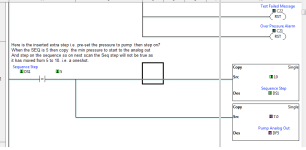drbitboy
Lifetime Supporting Member
Another typo at Subroutine 50 Test Pressure, Rung 5: high/low tolerance tests are reversed?

here are some of the key pieces of the algorithm that sets the air pressure regulator setpoint. At its core it does summat similar to what the human operator seems to be doing:
not shown are the 1-second group sampling metrics, used to determine "settled" and "above setpoint," a but they are simple.
- initially turn "knob" most of the way to a fixed value that should bring the system nearly to the setpoint
- with the known pump pressure ratio, the click can do this in one go
- this is state 20 start pump
- transition to next state at 10psi
- leave knob at initial fixed value, wait for pressure to settle
- it should settle a bit below the setpoint
- this is state 30 pump to initial stall
- transition to next state when settled
- current "settled" criterion is empirical and untested
- sneak up on setpoint from there
- "small moves, ellie, small moves" - tweak "knob" by ~1psi
- compare feedback from pressure sensor to setpoint
- stop if all sampled pressures for a full second are above the setpoint
- repeat at 1hz
- this is state 40 pump until test pressure
Sounds great.
I don't see how solenoid relief valve D can reduce pressure on the water discharge side of the pump, because the pump has check valves on the water side.
Also, valve D should never see more than 120psig.

